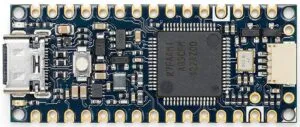Called Nano R4, it follows the Uno R4, the first Arduino to use the RA4M1.
“Whether you’re working on a connected device, a smart home application, or a space-constrained automation solution, the Nano R4 is designed to fit right in,” according to the company. “Nano R4 without headers is a module for more advanced users [with] castellated pins and single-sided components for soldering onto custom boards and ready for production. Designers working on commercial devices can prototype and scale while leveraging Arduino’s ecosystem.”
For connecting for sensors and peripherals, there is a 3.3V I2C interface via a ‘Qwiic’/’Stemma QT’ connector, and a 5V I2C port.
A connector is provided through which the microcontroller’s real-time clock can be battery-backed, and there is an RGB LED.
“Its compatibility with Arduino’s tools, libraries and the broader RA4M1-based ecosystem means you can re-use code and spend less time debugging,” said Arduino.
 If header pins are installed in the Nano, further expansion for sensors is available trough Arduino’s 28 x 43mm Nano Connector Carrier board (left), which adds one more I2C ‘Qwiic’/’Stemma QT’ connector and three ‘Grove’ style connectors for: UART, yet another I2C, and both analogue and digital IO. A Micro SD Card slot is also included, and the IO can be switched between 3.3V and 5V.
If header pins are installed in the Nano, further expansion for sensors is available trough Arduino’s 28 x 43mm Nano Connector Carrier board (left), which adds one more I2C ‘Qwiic’/’Stemma QT’ connector and three ‘Grove’ style connectors for: UART, yet another I2C, and both analogue and digital IO. A Micro SD Card slot is also included, and the IO can be switched between 3.3V and 5V.
Find the Nano R4 on this Arduino web page – there is also a version with pre-installed header pins.

